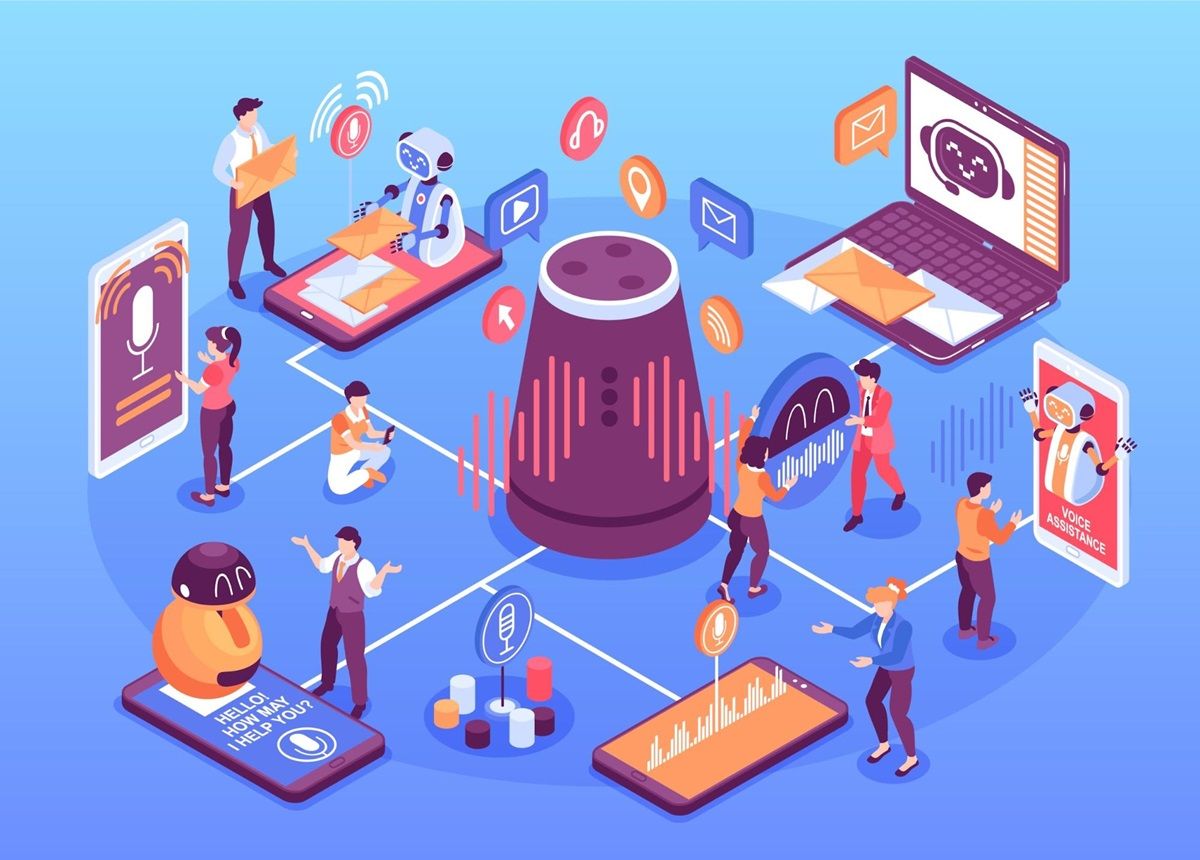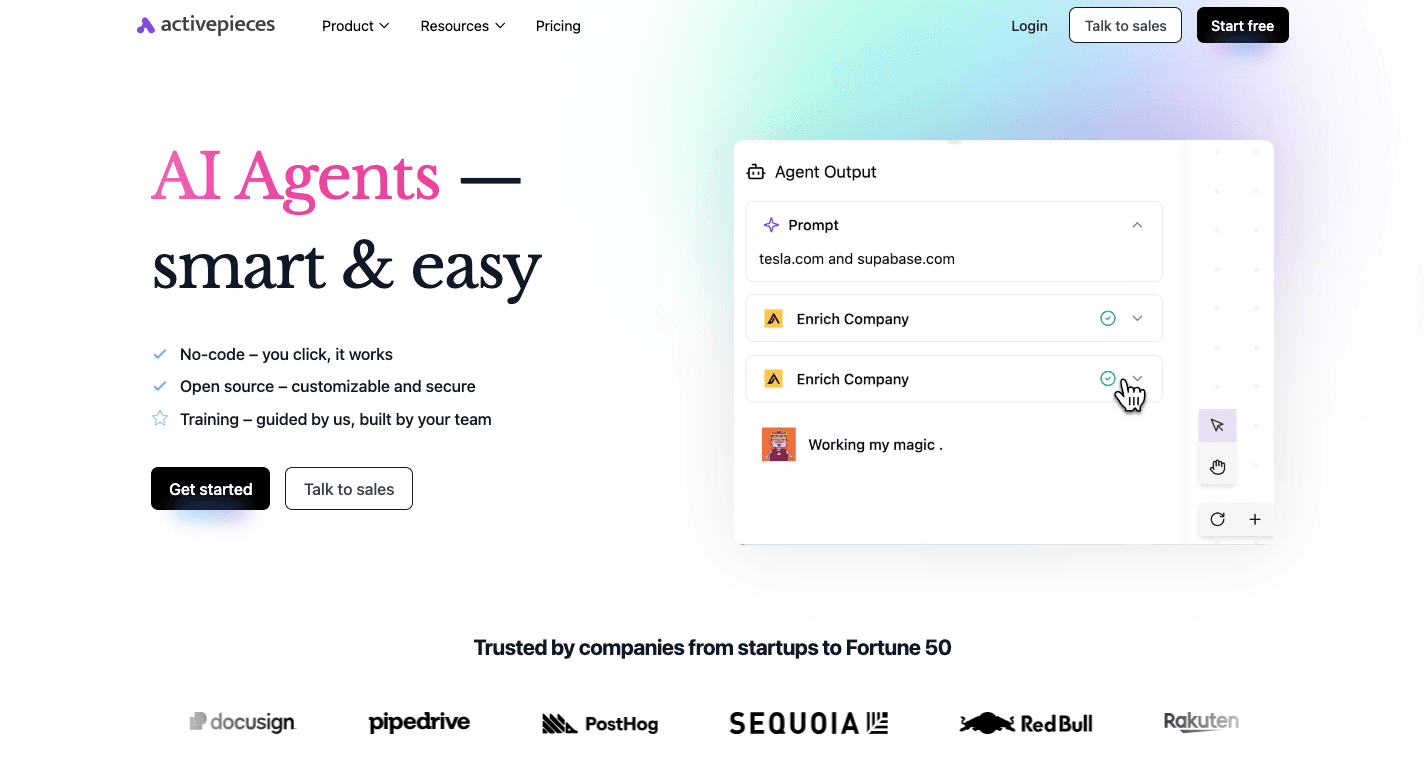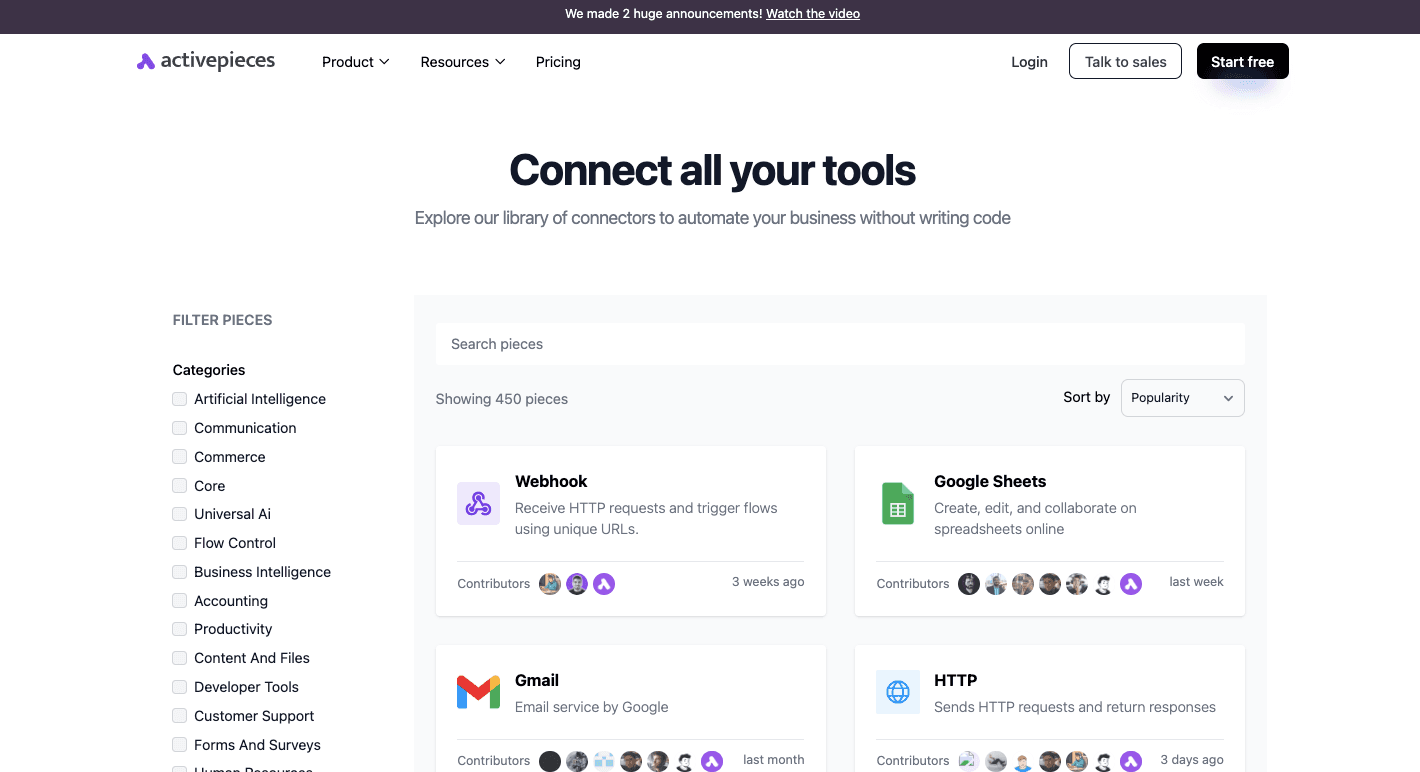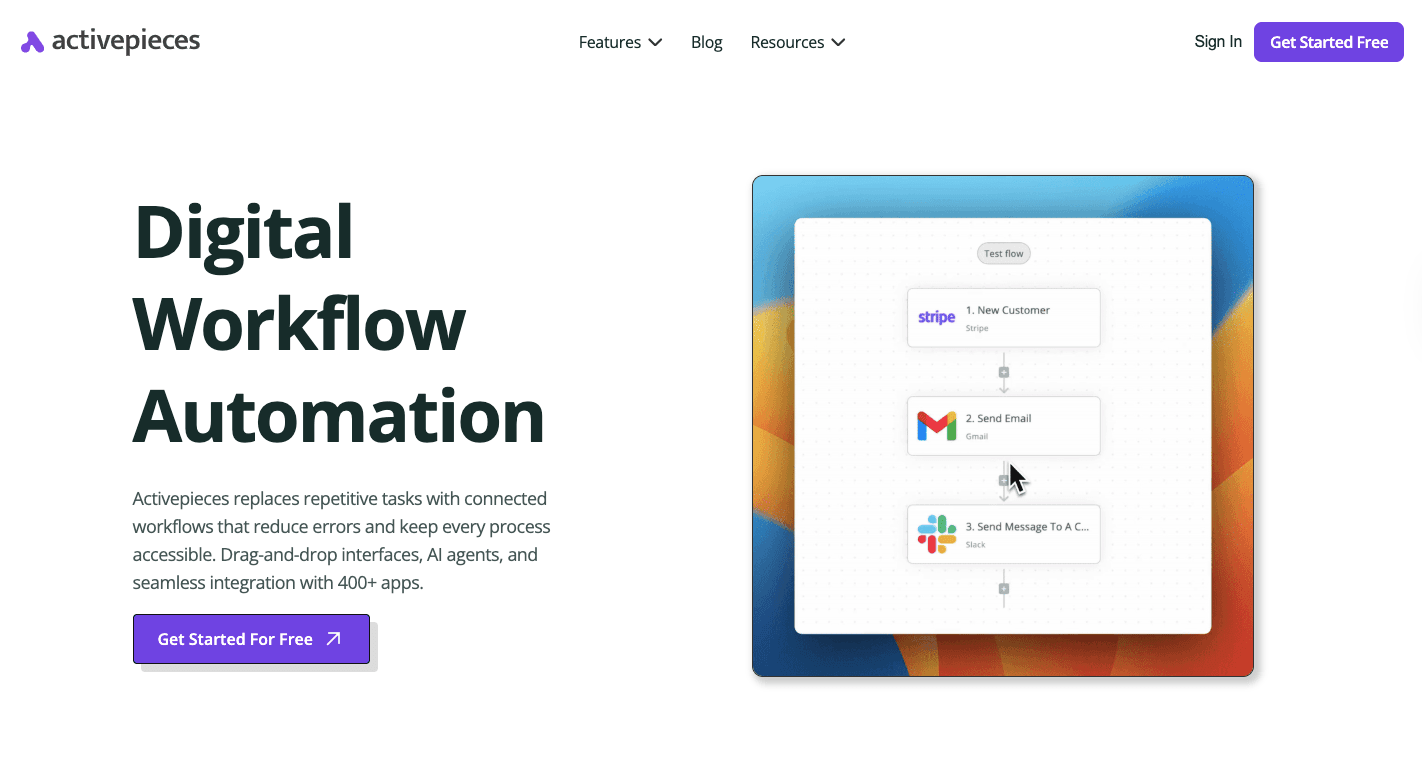Automation vs Hyperautomation: Which One's Right for You?

Many people talk about automation without realizing there's more to it. Some even use hyperautomation and automation as if they mean the same thing. They don't.
These two save time and reduce manual work but solve your problems differently. If you've ever wondered what separates one from the other, or which one fits your business, you're in the right place.
In this article, you'll learn the truth behind hyperautomation vs automation and how each helps you move from simple tasks to intelligent systems.
Join thousands who are already building the future of automation with Activepieces!
Key Differences Between Automation and Hyperautomation
While automation and hyperautomation streamline processes and improve efficiency, they differ significantly in various segments.
1. Scope
Here’s how automation and hyperautomation differ in scope:
Automation
Automation refers to using technology to handle specific, rule-based work within a process. It focuses on improving individual steps rather than the entire operation.
Automation mostly combines:
- Robotic process automation (RPA)
- Artificial intelligence (AI)
- Machine learning (ML)
- Traditional automation
- Business process management (BPM) tools
Although automation is limited to streamlining singular tasks or specific steps within a business process, it automates repetitive tasks that once needed human intervention, such as processing forms.
For example, an RPA bot can transfer order details from an email into a database to save time and cut down on errors.
Businesses usually use automation when tasks follow the same pattern every time. However, automation doesn't connect systems or adapt to change on its own, so improvements stay limited to clearly defined, rule-based steps.
Hyperautomation
If you decide to automate your entire order-to-cash workflow, it means integrating various technologies for the full process, from order entry to invoicing and payment collection. That's hyperautomation.
Hyperautomation refers to automating and optimizing your entire business processes across departments. It uses the following to streamline processes and manage dynamic processes that often involve more complex tasks:
- Intelligent process automation (IPA)
- Artificial intelligence
- Machine learning
This approach brings together multiple tools and data systems under one structure to create a holistic approach to automation.
In addition, hyperautomation connects every part of your process so you can identify inefficiencies and remove them continuously. It not only automates tasks but also helps you stay agile and adapt to AI-driven changes quickly.
We explained this in depth in our guide on the new enterprise AI setup.
2. Tools
Here’s how automation and hyperautomation differ in the tools they use:
Automation
Automation is a rigid and rule-based approach that's well-suited for simple repetitive tasks. It follows a predefined sequence of steps and finds it difficult to handle complex tasks.
To handle repeatable actions that don't require judgment in automation, you use tools that rely on fixed logic and predefined rules to keep tasks consistent. Most automation technologies include:
- Robotic process automation for digital data handling
- Business process management systems for managing workflows
- Integration-platform-as-a-service (iPaaS) platforms that connect apps through triggers and actions
Together, these automation systems help you save time and reduce manual work, but remain limited. Automation software often struggles with tasks that change frequently or require context.
Hyperautomation
Hyperautomation, on the other hand, is a more intelligent and adaptive approach. It brings together multiple technologies to create intelligent automation that can handle both structured and unstructured work.
For instance, it uses advanced technologies such as:
- Optical character recognition (OCR) to read documents
- Natural language processing to understand text
- Machine learning to learn from patterns and results
By coordinating these systems, it can analyze, decide, and act without manual reconfiguration.
Unlike traditional automation, hyperautomation platforms often provide a unified interface for managing and coordinating various automation tools.
The advanced practice of combining multiple technologies allows hyperautomation to manage high-volume work as it adapts to changes in data or process logic.
Why Activepieces Is the Leading Hyperautomation and Automation Tool

Activepieces is an open-source hyperautomation platform that integrates no-code with developer-level control.
Through its AI-ready foundation, Activepieces powers everything from simple workflow automations to full-scale enterprise hyperautomation setups. It supports organizations at every stage of digital transformation as well, maintaining strong data quality and performance consistency.
Unlike other platforms that require constant manual intervention, Activepieces operates through reusable open-source components called pieces. These pieces act as modular connectors to hundreds of apps and services.
Every function, from scheduling reports to syncing CRM data, can be built, tested, and deployed within minutes with Activepieces.
Key Features
- AI-ready automation – Connect to AI providers or build your own intelligent agents using the built-in AI Copilot and SDK inside the flow builder.
- Open ecosystem – Every integration, or piece, is open source and available on npm, with over half contributed by the global community.
- Developer-friendly build – Written entirely in TypeScript, which offers full customization, hot reloading, and a frictionless developer experience.
- Enterprise-grade security – Self-hosting capabilities eliminate cloud dependency and give you total data control, reducing security risks.
- Human-in-loop design – Add approvals, hold actions, or schedule triggers.
- No-code builder – Drag-and-drop flow creation for marketing, sales, and IT teams without technical backgrounds.
Use Cases
Activepieces supports automation across multiple industries and departments. Businesses often use it to:
- Automate lead capture, nurture sequences, and content distribution
- Sync CRM data, score leads, and send personalized follow-ups automatically
- Monitor system alerts and trigger automatic fixes for performance issues
- Streamline inventory updates and recurring reporting tasks
- Route tickets, update records, and manage replies using AI chatbots
Every automation you build on Activepieces reduces repetitive processes, improves coordination, and delivers faster results.
Integrations
As of the moment, Activepieces currently offers 450 pre-built integrations, and that number continues to grow through community contributions.

These data integrations span essential business functions and modern tools:
- Google AI Studio (Gemini)
- IBM Cognos Analytics
- Slack
- HTTP
- ClickUp
- Microsoft Excel 365
- WordPress
- ActiveCampaign
- HubSpot
- Zoho CRM
- Microsoft Dynamics CRM
Such variety means Activepieces can fit seamlessly into nearly any workflow. Whether you're connecting sales operations or customer support tools, it helps maintain consistency and stability across all your integrated systems.
Reach out to sales and see how Activepieces makes enterprise automation simple!
3. Decision-Making Capabilities
Here’s how automation and hyperautomation differ in decision-making capabilities:
Automation
Traditional automation handles specific tasks by executing each step in a specific sequence. You won't see it stray from the script or instructions it was provided with.
It performs better if you're assuming an ideal environment where there are no conflicts to be resolved or no nuances to consider. But that’s rarely the case.
Systems built for automation follow if-then logic to reduce human error and maintain accuracy in predictable environments. These systems are useful for routine operations like data entry or record matching, where outcomes don't shift often.
Once exceptions appear, they need human review. That's why implementing automation still requires oversight for edge cases or unexpected data.
Hyperautomation
As your business grew, so did the complexity of the orders. That's when you start encountering issues that traditional automation couldn't handle. For example, if there was a conflict in the order details or a delay in payment, the system would halt, waiting for human intervention.
Hyperautomation handles decisions differently. It uses AI and analytics to analyze data, recognize trends, and respond based on context. When a sudden surge in demand occurs, hyperautomation can adjust workflows and resources automatically.
Traditional automation would have struggled to keep up, which leads to delays and errors. However, with a hyperautomation setup, the system makes informed decisions by analyzing incoming data and predicting surges. It then adjusts inventory levels in real time.
4. Integration
Here’s how automation and hyperautomation differ in integration abilities:
Automation
Automation often involves integrating with other systems so individual tasks can run smoothly without manual effort, but the level of integration can be limited. It might be able to connect to a few specific systems, but it might struggle with more complex integrations or data exchanges.
To pass information from one app to another automatically, it links software through:
- APIs
- Webhooks
- Connectors
In most setups, automation handles small-scale connections. For example, an integration platform can push customer data from a form into a CRM or trigger an invoice email once payment is received.
These setups improve speed, but they still focus on single workflows. Since each tool handles its own piece, there will be gaps between systems that don't share data directly.
Hyperautomation
Hyperautomation, on the other hand, focuses on seamless integration. It aims to connect various systems, tools, and data sources to create interconnected workflows.
For instance, a hyperautomated supply chain might sync with an inventory system, transport network, and CRM in real time. Data from each source updates the others automatically to let every part of the operation respond to changes instantly.
In essence, automation is about connecting a few pieces, while hyperautomation is about building a well-connected network.
By integrating multiple systems through a unified platform, hyperautomation breaks down barriers between departments. It drives consistency, improves accuracy, and gives you a complete view of your business processes.
5. Continuous Improvement
Here’s how automation and hyperautomation differ in development:
Automation
Automation often involves periodic updates and refinements. You might need to make changes to the system from time to time to address new requirements or fix issues. It depends on you to spot issues and push updates.
When a process shifts, basic automation solutions may require manual adjustments to keep working correctly. You need to modify scripts, rebuild logic, or reset workflows before they can implement improvements automatically.
These systems do well with simple task automation but don't adapt on their own. Every improvement cycle begins with human observation: someone must notice a drop in performance or an error before the update happens.
Overall, automation continues to focus on local optimizations instead of improving how the entire operation connects or evolves.
Hyperautomation
Hyperautomation, on the other hand, emphasizes continuous improvement. It uses data-driven insights and AI to identify opportunities for optimization. The system can learn from its experiences, adapt to changing conditions, and continuously improve its performance.
Hyperautomation also manages complex business processes that require constant refinement without waiting for manual fixes. It studies live data, finds slow points, and improves them automatically through AI-driven insights.
It's similar to a machine that tunes itself while running. The system observes performance, learns from results, and adjusts future actions without pausing for reprogramming.
Although human oversight still matters, hyperautomation creates an environment where improvement becomes a built-in habit.
Examples of Automation vs Hyperautomation in Different Departments
Is hyperautomation just hype or reality?
Let's explore the differences between automation and hyperautomation in terms of use cases.
Finance and Accounting
Automation in finance and accounting often performs tasks, such as report generation. While it minimizes manual tasks, it doesn't address the complexities and potential issues that arise in real-world financial transactions.
In contrast, hyperautomation uses AI and ML to create a more sophisticated and intelligent system. AI-powered systems accurately extract information from invoices, including vendor details, invoice numbers, dates, and line items.
Going beyond simple data processing, hyperautomation also assists in negotiations in the following way:
- AI can analyze market data to determine fair prices for goods and services.
- The system can suggest negotiation strategies based on historical data, supplier relationships, and current market conditions.
- In certain cases, the system can even automate simple negotiations, such as requesting discounts or negotiating payment terms.
Human Resources
Traditional automation in HR often focuses on automating routine tasks, such as sending welcome emails or setting up access to systems. It cuts down repetitive work but can't make decisions about candidate quality or fit.
Meanwhile, hyperautomation uses AI to scan resumes, rank applicants, and predict cultural alignment. Once candidates are selected, the system can personalize onboarding, assigning training based on job level or learning style.
It can also track engagement and retention trends to guide HR leaders toward stronger workforce planning. Hyperautomation gives HR teams the ability to focus on people while the system manages the flow of processes behind the scenes.
Customer Service
Automation in customer service often involves using chatbots to handle simple, repetitive inquiries. It improves your response time by managing basic customer interactions like order tracking or password resets. Still, it struggles with complex requests that require empathy or context.
Hyperautomation addresses this by using AI-powered chatbots that process data from multiple systems to understand and respond like a human.
Through sentiment analysis and behavior tracking, these tools deliver personalized support and recommendations. That results in a smoother customer experience, where users get faster, more accurate answers, and agents can focus on higher-value cases.
IT Operations
Traditional automation in IT operations often involves automating routine tasks, such as software updates. Yet, it struggles with issues that require significant effort to diagnose and fix.
On the contrary, hyperautomation combines predictive analytics, AI, and monitoring tools to identify risks and resolve them before they impact users. When it detects anomalies, the system can automatically restart servers, apply patches, or rebalance workloads.
Over time, hyperautomation learns from performance data to prevent future failures.
Move Beyond Automation and Unlock Hyperautomation With Activepieces

Automation helps companies move faster, but it often stops short of full transformation. Many teams still depend on manual processes that slow progress and create gaps between systems.
That's where Activepieces steps in, an open-source, enterprise-grade platform designed to automate as many business functions as possible.
It lets you design and automate complex workflows using a visual, no-code builder that anyone can use. You can even build and deploy intelligent automations that quickly adapt to new data, changing conditions, or growing workloads.
Every piece inside Activepieces is open source and fully customizable. You can host it yourself for total data control or use the cloud version for convenience.
With a secure architecture, seamless AI integration, and support for human-in-the-loop approvals, Activepieces helps you eliminate inefficiency, automate intelligently, and scale operations without limits.
Begin your hyperautomation journey with Activepieces now!
FAQs About Automation vs Hyperautomation
What are the common hyperautomation benefits?
Common hyperautomation benefits include faster execution of entire workflows, reduced operational costs, and improved accuracy.
It helps businesses move beyond rule-based tasks by combining AI and machine learning to automate processes that once required cognitive abilities.
What are the four types of automation?
The four types of automation are fixed automation, programmable automation, flexible automation, and intelligent automation.
What is the difference between automation and hyperautomation?
Automation handles specific, repetitive, and rule-based tasks, while hyperautomation uses advanced technologies like AI and machine learning to automate entire workflows across departments.
Hyperautomation reduces manual intervention and adapts to complex, changing processes.
What are the four stages of process automation?
The four stages are: identifying processes, automating rule-based tasks, optimizing workflows with analytics, and scaling automation across the organization through AI and machine learning.
What are the different automation benefits?
Key automation benefits include higher efficiency, lower operational costs, fewer human errors, and consistent performance in rule-based tasks.
Does automation and hyperautomation use artificial intelligence?
Yes. While traditional automation relies on pre-set rules, automation and hyperautomation increasingly use AI to analyze data and make informed, adaptive decisions.


